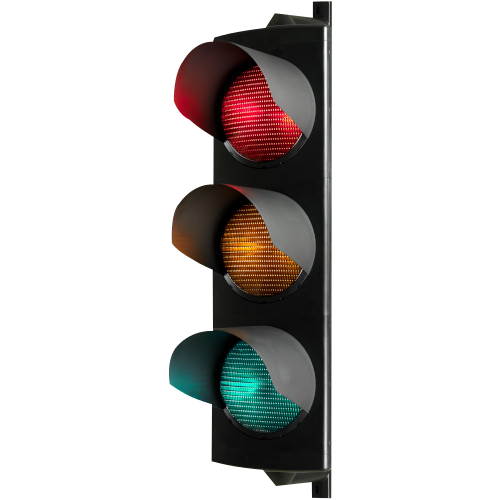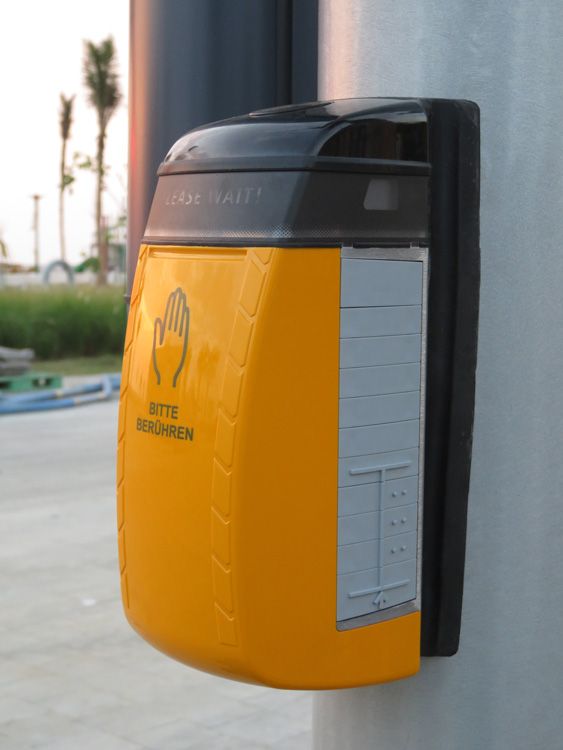SWARCO’s Pioneering Journey in the Middle East: A Legacy of Innovation and Determination

When SWARCO was founded in 1969 in Austria, few could have predicted the incredible growth the company would experience over the following decades. A defining moment in this remarkable trajectory occurred in the mid-1970s when the company ventured into the Middle East, inspired by the visionary leadership of its founder, Manfred Swarovski, along with a dedicated team of professionals. Their relentless efforts laid the foundation for SWARCO’s success in the region, overcoming challenges and establishing a strong reputation for quality and innovation.
An Unexpected Beginning
The captivating tale of SWARCO's journey in the Middle East began in an unforeseen setting. During a chance meeting in London in 1974 Manfred Swarovski encountered an Arab businessman, sparking what would blossom into a decade-long venture. This brief intermezzo resulted in a young SWARCO team finding itself at Vienna Airport and gearing up for the first significant assignment—introducing road marking solutions to the Middle East. This ambitious undertaking, humorously dubbed “A Thousand and One Glass Beads,” would significantly enhance SWARCO’s legacy.
1970s
Traffic and Road Infrastructure in the 70s
At this time, the traffic and road infrastructure in the largest Arab country on the Arabian Peninsula Saudi Arabia had just begun to develop. Before the 1970s, Saudi Arabia had a limited network of roads, with only a few paved roads and highways connecting major cities like Riyadh, Jeddah and Dammam. Only a few paved roads for road markings? One might think that this did not sound that interesting for SWARCO. However, the oil boom of the following century led to large-scale investments in infrastructure and by the late 1970s thousands of kilometers of paved highways were constructed, including the Riyad-Dammam Highway and the Jeddah-Mecca Expressway. The private car became a symbol of status and the increased vehicle ownership due to economic prosperity consequently brought the first challenges for managing urban transportation. Although traffic congestion was not as severe as today, road safety fast became a major issue and accidents and fatalities were high due to speeding, lack of proper road signage and limited enforcement of traffic laws. An ideal situation for SWARCO's competence. There were no advanced traffic management systems and many traffic arteries lacked streetlights, pedestrian crossings or even traffic signals. The situation in the United Arab Emirates was lacking behind, as the country was only formed in 1971. In Dubai and Abhu Dhabi, most roads were unpaved, and transport relied heavily on basic road networks. One of the least developed road networks in the region could be found in Oman with less than 20km of paved roads in the entire country. The infrastructure of roads and traffic conditions were different in Kuwait, Bahrain, Iraq and Egypt. Although the road networks were relatively well-established, the road conditions were aging with high accident rates due to lack of traffic management combined with growing urbanization. In short, there was a lot to do for SWARCO.
FACT BOX
MEANWHILE IN EUROPE
Compared to Saudi Arabia, the European motorway network was already well developed in the 1970s. Some governments, such as those in Germany and the Netherlands, implemented car-free days, while public transport was widely used in cities like Paris, London, and Berlin.
Several cities had already introduced dedicated bus lanes and early traffic control systems to optimize traffic flow. Road safety became a growing priority, with most European countries introducing mandatory seatbelt laws, stricter drunk driving regulations, and national speed limits.
SAUDI ARABIA
Overcoming Challenges
Around 1976, Riyadh had evolved into a vibrant metropolis, exceeding one million residents (today, there are around seven million). Within this context, a small SWARCO team went on a mission to lay the first test road studs in front of the police headquarters. It wasn’t an easy journey; nearly two years passed before SWARCO’s innovative ceramic product, equipped with embedded glass beads for nighttime retro-reflection, secured its first contract.
Faced with extreme asphalt temperatures soaring above 70 degrees Celsius, alongside sandy winds and high tire abrasion, along with cultural differences, the challenges were significant. Yet, through unwavering determination, the team utilized high-quality Austrian and German materials and expertise, thereby solidifying SWARCO's reputation as a trusted partner in the region.
OMAN
Unexpected Encounters
Always when we thought we've seen it all, we were surprised all over again. This also happened in Oman: SWARCO’s entry into Oman brought forth an unusual—and somewhat amusing—challenge. During a test marking demonstration in Muscat, the team’s reflective traffic cones mysteriously vanished. Although the staff were initially unaware of the incident, the cones made a surprising reappearance days later, strategically positioned at a police checkpoint.
Such unexpected experiences highlight the unpredictable yet ultimately rewarding nature of entering new markets, creating cherished memories for those who participated in this fascinating journey.
IRAQ
Baghdad in the late 1970s
Toward the end of the 1970s, Baghdad was a vibrant, cosmopolitan city, alive with cultural events and a flourishing arts scene. We, too, played a role in shaping that dynamic spirit. But how?
Starting in 1978, SWARCO undertook significant road marking projects in Baghdad, notably a major 400 km stretch from Baghdad to Mosul. SWARCO was a real pioneer in road marking in Iraq. Equipped with the most modern and largest marking machines that were being produced at our plant in Amstetten at the time, SWARCO marked another 600km of road projects from Bagdad to Basra.
50 years ago, our machines already featured paint tanks with a capacity of 3 to 15 tons, mounted on medium and large trucks. During the 70s, the concept of pedestrian crossings was largely unfamiliar to the local populace, necessitating dedicated awareness campaigns involving uniformed officers guiding pedestrians across roads. Although subsequent business developments faced challenges due to the Iran-Iraq conflict, these early initiatives were pivotal in shaping the county’s urban infrastructure as well as the company’s future.
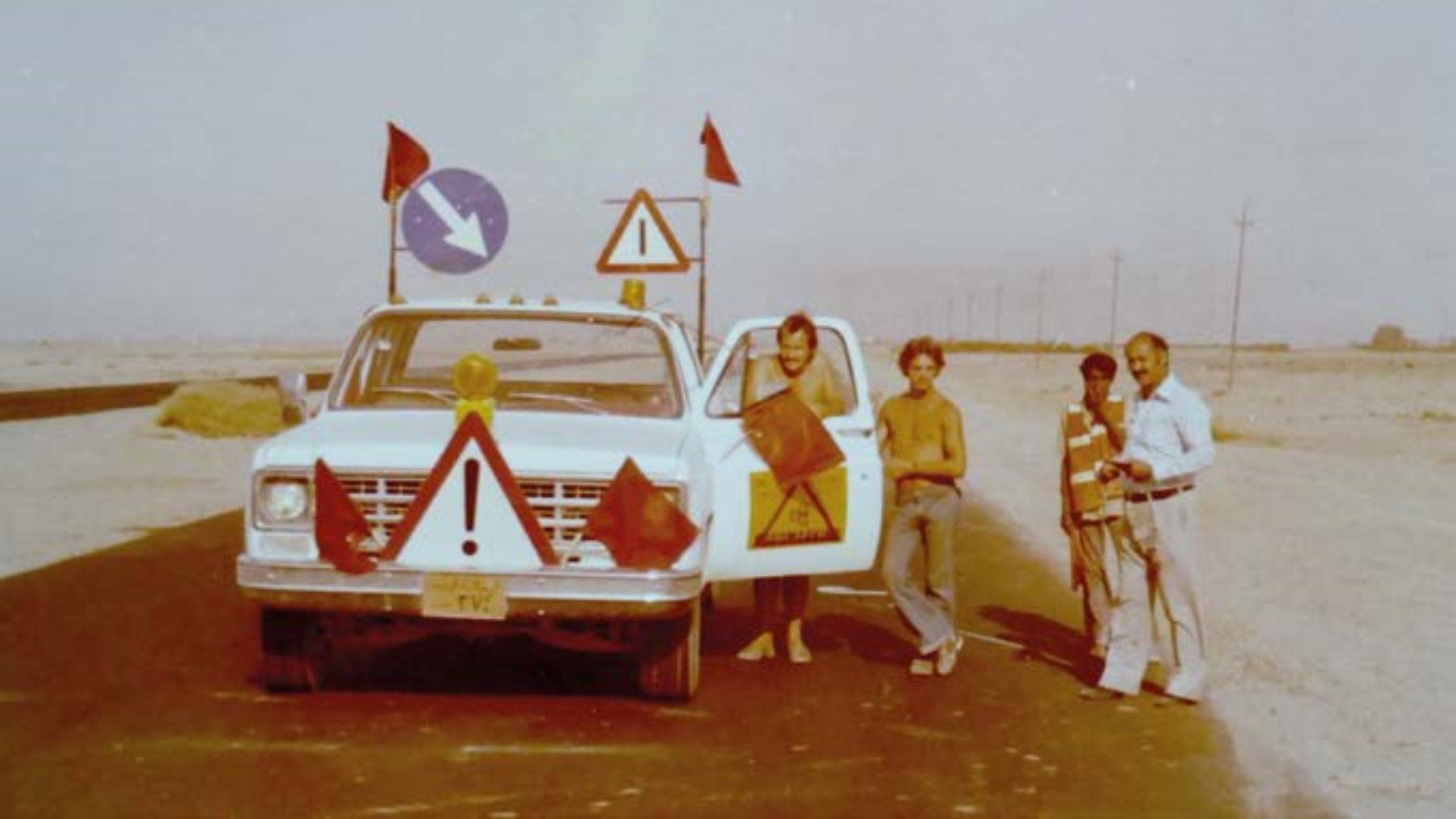
"Safety car" for the safety of the striping crew
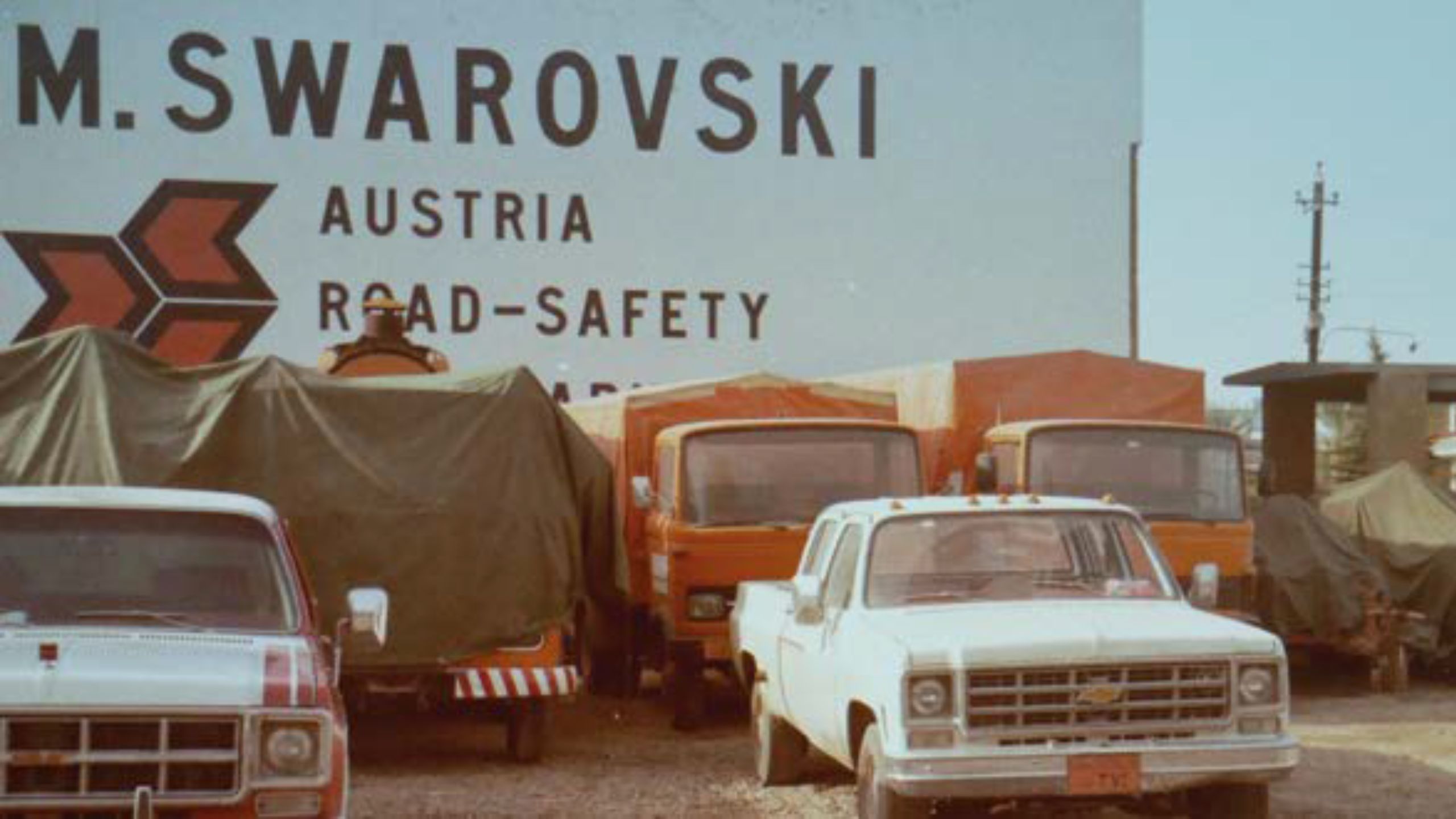
SWARCO central office in Baghdad in the 70s and 80s
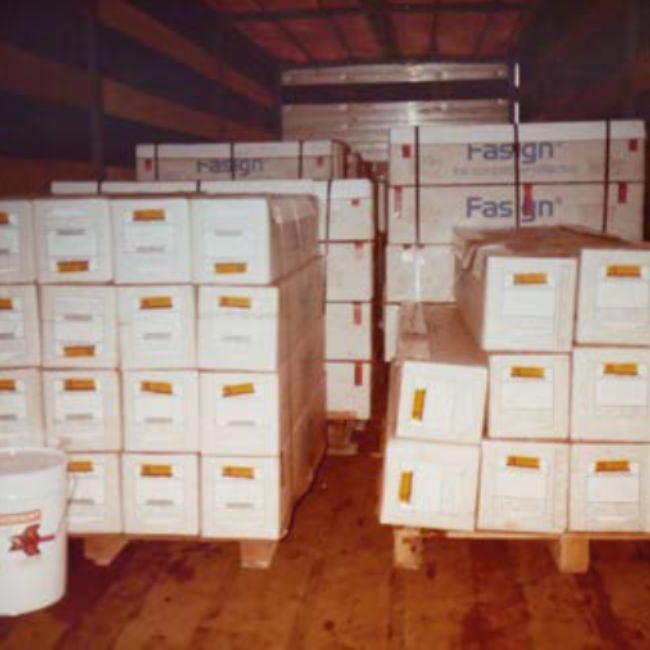
Road marking material made in Austria
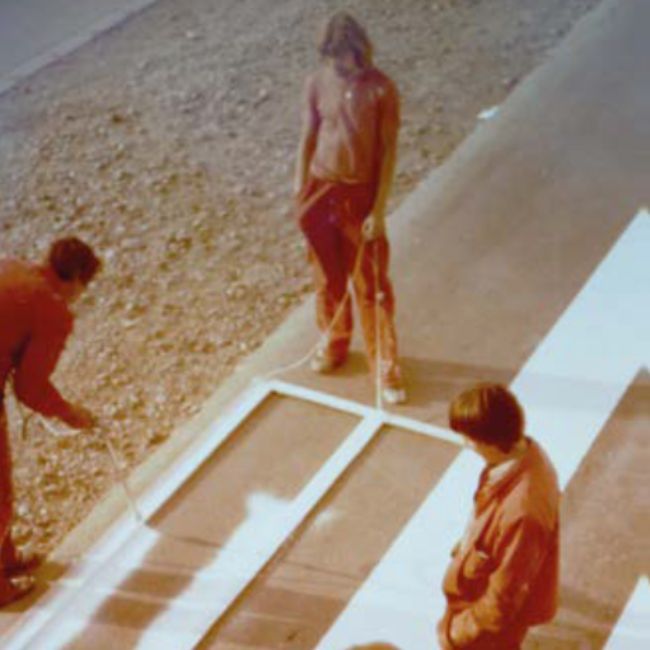
Marking roads in the Arabian desert is still a tough job for real men
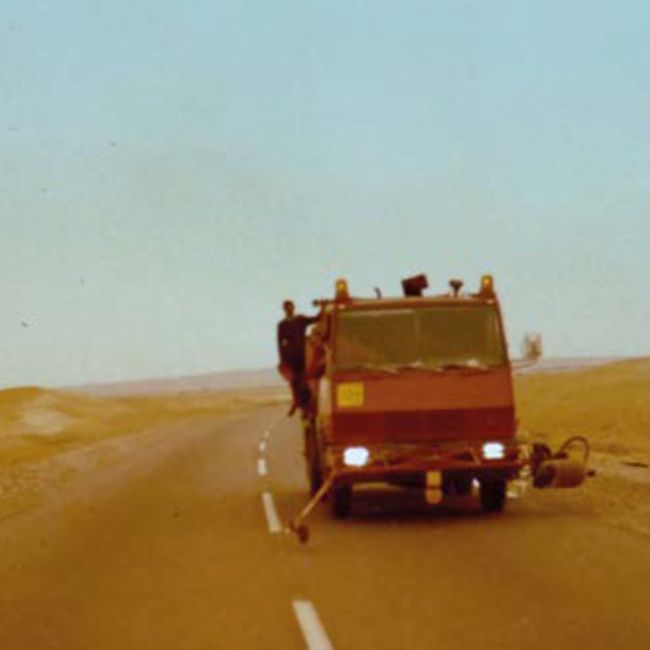
Truck with road striping material
1980s
Shipping a glass bead production facility from San Marino to the Kingdom of Saudi Arabia
During the 1980s, SWARCO’s efforts to improve road safety in the Gulf region reached a new level. With the acquisition of the Al Salamah Road Paint Factory—a producer of thermoplastic road marking materials which are often used in hot climates—SWARCO made a strategic decision to relocate a glass bead production facility from San Marino to Riyadh. An in-house SWARCO assembly team dismantled the equipment, shipped it to SaudiArabia, and reinstalled the plant on Al Salamah’s premises. The result was a high-quality glass bead production site, supplying markets in Saudi Arabia, the Middle East and North Africa. This chapter culminated in the acquisition of Safety Arabia, a road marking company and long-time SWARCO customer.
1990s
The first LED signal heads for the Middle East
The 1990s marked a transformative period in the Middle East in regards of road infrastructure, traffic management and regional connectivity. A remarkable highlight were the Dubai-Abu Dhabi Highway expansion into Sheikkh Zayed Road with four lanes in each direction, the completion of the Mudeirej Bridge in Lebanon as the tallest bridge in the Middle East at the time or the introduction of speed enforcement systems and the planning of public transport in city centers in Saudi Arabia or the United Arab Emirates in order to enhance traffic safety and efficiency.
Although traffic control and management systems did exist, the hard- as well as software were in its early stages. Traffic signal heads were including incandescent bulbs or halogen and screamed for an update. SWARCO Futurit, the leading manufacturer of energy efficient signal heads in Austria, achieved a milestone in the Gulf with a comprehensive exchange and installation of modern signal heads – the first LED traffic lights in the region.
Word of the high quality of our traffic lights spread quickly:
- Kuwait: starting in the 1990s, now almost the whole country is equipped with SWARCO FUTURA signal heads
- Dubai: The whole emirate runs the SWARCO FUTURA and SWARCO ALUSTAR signal heads
- Ras Al Khaima is using SWARCO ALUSTAR as well
- The same situation in Abu Dhabi and Al Ain, ALUSTAR traffic light installations
- Muscat: The whole city uses ALUSTAR from SWARCO Futurit
- Amman: until late 2010s equipped with SWARCO Futurit Standard model
- Beirut: the SWARCO FUTURA signal head was the major player found at intersections
- Yemen started to install high quality signal heads from SWARCO Futurit
- Qatar: every signal head in the state was Futurit Standard and is now in the transition to upgrade to the SWARCO COMBIA and ALUSTAR
Traffic lights only? Our expertise goes far beyond!
Further components for running intersections at high performance included different controlling units like our ITC-2 and ITC-3 or traffic light controllers from SWARCO McCain. The OMNIA traffic management platform from SWARCO Mizar in Turin (now SWARCO ITALIA), sometimes in combination with Utopia, functioned as the heart and umbrella software suite to not only control and manage the high number of intersections, but also to integrate other components (for example variable message signs, which became more and more popular in the Gulf at the time).
2000s
The dawning of a new age
An eye on the Kingdoms transportation infrastructure and traffic management systems during the 2000-2010 decade
Between 2000 and 2010, Saudi Arabia experienced significant developments in its mobility landscape, traffic management, and road infrastructure. According to the CIA World Factbook, by 2009, the Kingdom's road network encompassed approximately 221,372 kilometers, with 47,529 kilometers paved, including 3,891 kilometers of expressways. This extensive network facilitated connectivity between major cities and remote areas, supporting economic activities and regional integration. The expansion and maintenance of the road network played a crucial role in the Kingdom's economic development, facilitating trade and access to remote areas. The government's investment in road infrastructure not only aimed to support economic diversification and regional development but furthermore improve safety, reduce congestion and build the foundation for better traffic flow, a competence SWARCO was establishing at this time by acquiring its first traffic management company in the ITS sector in Europe.
FACT BOX
TRAFFIC SAFETY CONCERNS
Despite these efforts, traffic accidents remained a significant concern during this period. Between 1999 and 2009, approximately 50,000 fatalities and over 300,000 injuries were recorded due to road accidents, resulting in an economic loss of around SR100 billions. SOURCE
SWARCO goes ITS in GCC
In 2008 SWARCO entered the public transport market in the gulf region by starting the implementation of public transport and management as well as real time passenger information system in Sharja Emirate. This milestone included the management of a fleet of 142 buses with a local partner. When SWARCO SAUDIA LLC was founded in 2011, it marked a significant entry into a challenging yet promising regional ITS (Intelligent Transportation Systems) market, representing a major breakthrough for SWARCO in the GCC region. Initially set up as a project company for an integrated ITS platform for traffic monitoring and control for a dozen intersections in Salalah, it gained operational independence in 2013. From the very beginning, SWARCO's vision was to introduce cutting-edge ITS to the Kingdom and its neighbouring states, tapping into vast opportunities within urban traffic management, parking systems, and variable message signage (VMS). However, as we were already used to, this story was not running 100% smooth either. Nevertheless, all SWARCO projects from 2012 onwards included a record breaking number of roughly 1000 intersections until now, including traffic monitoring, control and management not only in Saudi Arabia but also in Qatar, Kuwait City and Abu Dhabi.
It was a road filled with hurdles...
In those early years, Saudi Arabia presented a conservative and relatively closed environment, posing challenges for foreign investors. Success hinged not only on technical know-how but also on establishing trust with local stakeholders. Delivering on commitments, ensuring high quality, and demonstrating long-term reliability were crucial for gaining a foothold in the market.
...but each one strengthened our resolve
Despite these challenges, SWARCO quickly positioned itself as a key player in the region. A significant milestone for the SWARCO subsidiary in Saudi Arabia was achieved in 2013 when the company installed the initial traffic intersections for the Airport Housing organization. This success paved the way for further achievements:
- 2011-2013 integration of the first ITS platform for traffic monitoring and control in Salalah
- 2012 area-wide upgrade of intersections, controllers and software integration in Abu Dhabi
- 2013 integration of traffic monitoring and control system for 325 intersections in Kuwait City
- 2014 implementation of the first tunnel LaneLight project
- followed by the 2016 installation of SWARCO’s first VMS in Saudi Arabia
- The deployment of the first SWARCO NEMA controller in Riyadh in 2017 solidified its reputation further.
- Moreover, the company's largest single Traffic Signal Hardware (TSH) order for the Riyadh Adaptive Traffic Control System (ATCS) project in 2015 underscored its growing influence
- 2017 nationwide adaptive traffic management system in Kuwait
- 2019 software integration to manage all ITS in all of Qatar! Also in Alain City in Abu Dhabi Emirate full SWARCO controllers, signal heads, variable message sings and Utopia/Omnia software.
SWARCO SAUDIA LLC
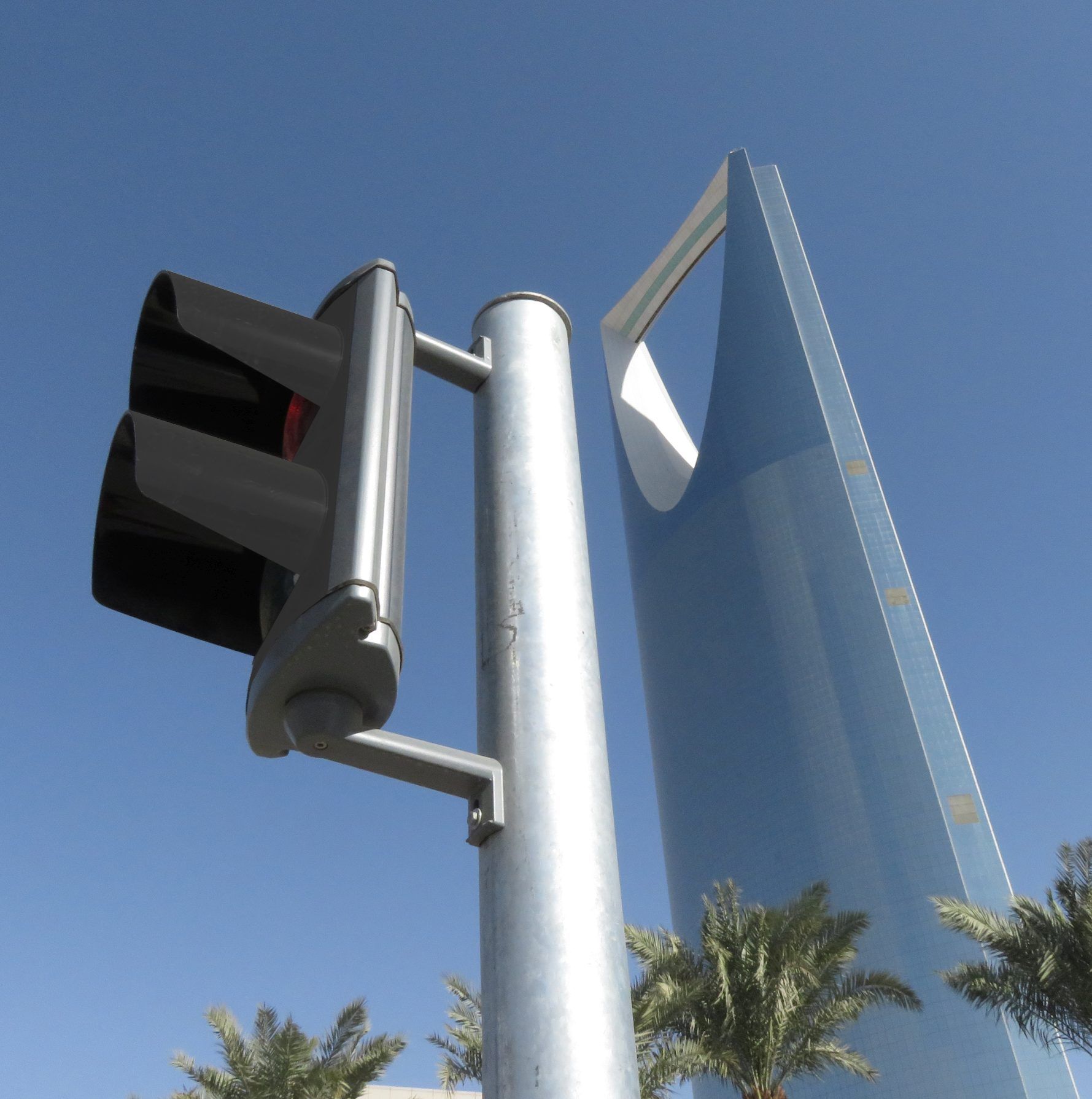
Our traffic management experts in the Middle East
SWARCO has long-standing business relations with Saudi-Arabia, both in Road Marking Systems and Intelligent Transport Systems.
SWARCO Saudia in Riyadh is our system integrator, design, service, and project management company for KSA, but also looks after the ITS markets in Kuwait, Bahrain, and Egypt.
With a staff of 100+, the company supports Saudi-Arabia’s ambitious traffic infrastructure expansion and upgrade projects with excellent products from the SWARCO hardware and software portfolio.
ITS references from the past fifteen years refer to intersection control, LED-based traffic lights and variable message signs, lane control signals, Weigh-in-Motion (WIM), vehicle height control, intersection maintenance, and parking management and can be found in Riyadh, Dammam, Jeddah, Yanbu, Jubail, Medina, and other cities.
Company Details
Mousa Ibn Naseer
2nd Floor Cercon Building #6,
Ar Riyadh 12241
Kingdom of Saudi Arabia
NOW
Reputation is no longer a destination – it’s where we stand
Today, SWARCO remains a major force in the field of advanced traffic management solutions, contributing to prestigious projects such as the King Salman Park Tunnel, Qiddiya, the Sports Boulevard or Jeddah Waterfront. Furthermore, SWARCO is a reliable partner for remarkable projects in Qatar, Abu Dhabi, Oman and Iraq. What began as a small sales-focused entity has transformed into a comprehensive ITS provider, covering the entire value chain from supply to installation and maintenance of traffic management equipment and software such as traffic signals, traffic controllers, variable message signs, speed limit signs, passenger information displays or fully integrated software platforms. SWARCO also supports projects where an efficient and stress-less parking experience has priority. This can be around airports, malls, shopping centers, sport arenas, hotels, hospitals, entertainment and theme parks.
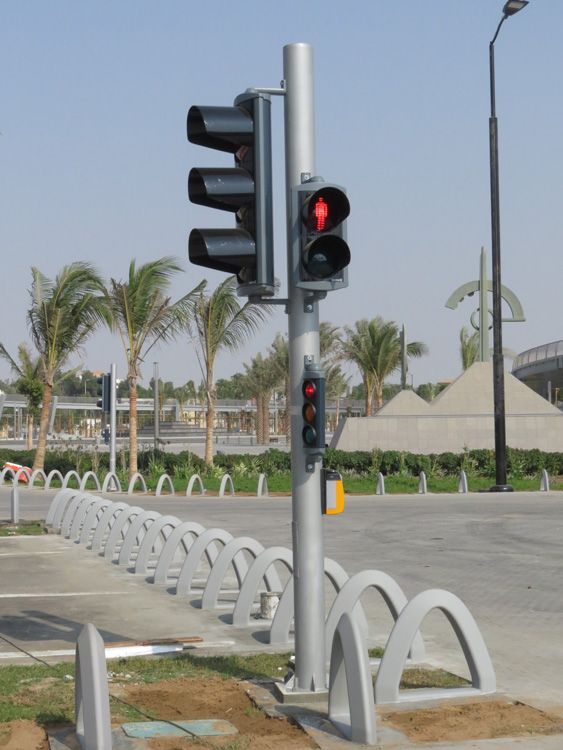
Traffic light installation with push button for pedestrians on an intersection at Jeddah Waterfront
The TOUCH SOUND push button, an all-in-one solution with multiple features
SWARCO Saudia has established itself as a leading mobility management partner across the Arabian Peninsula, offering a comprehensive portfolio that spans from single intersection design to advanced and connected traffic management solutions for tunnels, highways and whole cities. High quality road marking systems and high index glass beads with best visibility and durability for increased road safety, especially in desert environments, complete the portfolio. The company’s approach is centered on optimizing safety, efficiency, and sustainability of urban as well as interurban mobility systems, while ensuring long-term operational viability and minimized lifecycle costs. This strategic positioning, coupled with its commitment to future-ready transport infrastructure, is mirrored in its dynamic growth — evolving from a modest team of five at its founding to a workforce nearing 150 highly skilled professionals today.
SWARCOs success story exemplifies resilience, expertise, and a commitment to excellence. It highlights the importance of adaptability and trust-building in new markets. The lessons learned in Saudi Arabia and the countries around will undoubtedly serve as a model for future expansions throughout the Middle East.
More than four decades since its first footstep, it is clear that SWARCO is not just in the market—it is here to stay.
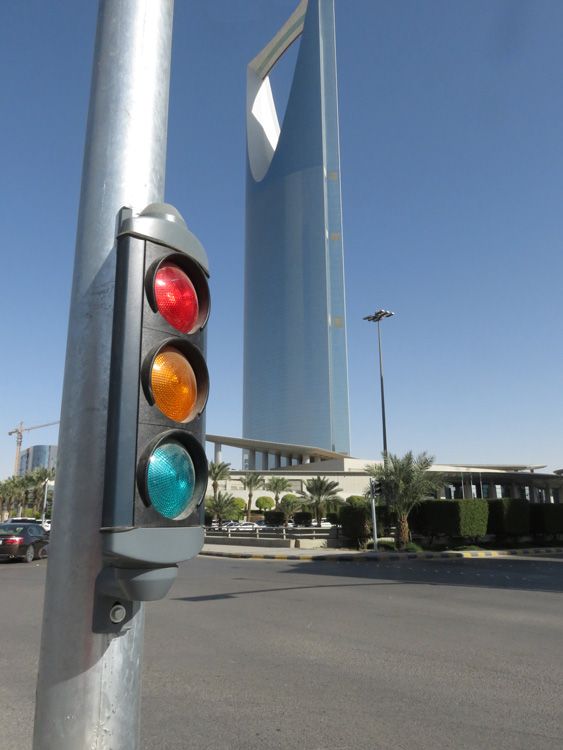
SWARCO Traffic Signals adorn the city center of Riyadh and manage traffic effectively in Saudi Arabia
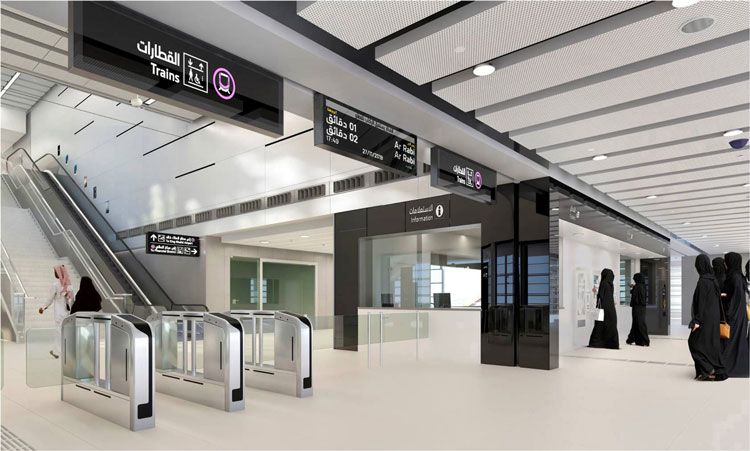
Passenger Information Displays do not only provide real-time-information, they also guide passengers
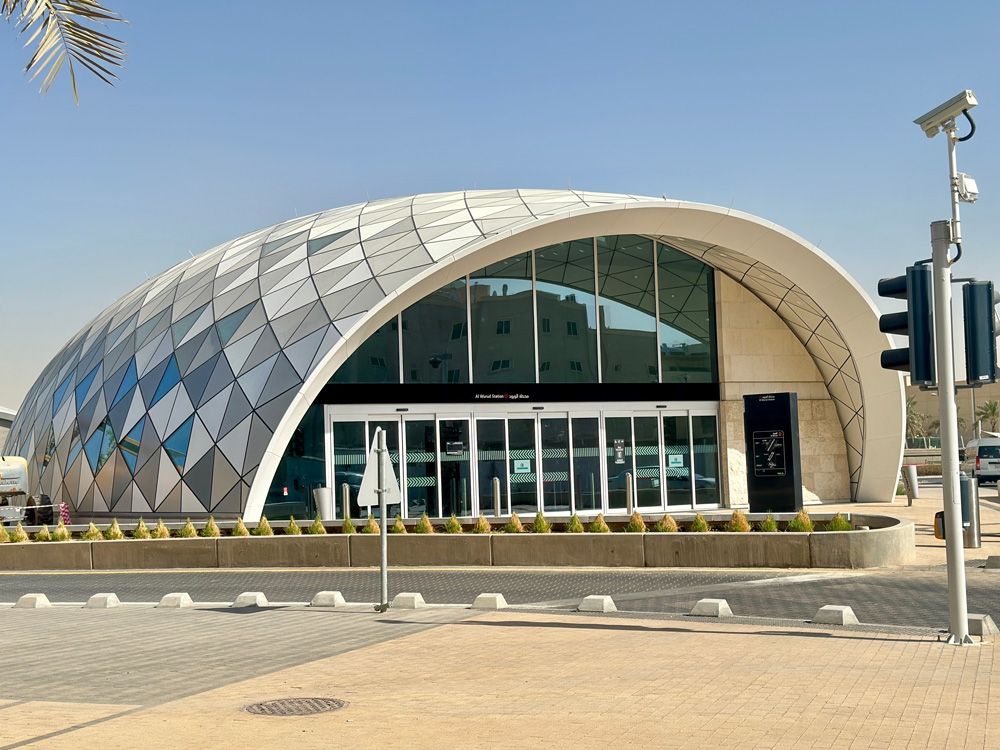
SWARCO installations around the Riyadh Metro provide safety for pedestrians
FACT BOX
SAUDI ARABIAs TRANSPORT NOW
The Kingdom's road network extended to 316,900 kilometers in 2023, a 2.2% increase from the previous year. This includes 194,400 kilometers within cities and 74,200 kilometers of intercity roads. The quality of Saudi Arabia's roads has also improved, with the country achieving a road quality index score of 5.7, placing it fourth among G20 countries. SOURCE
The Kingdom has made significant strides in reducing traffic-related fatalities. Between 2016 and 2021, road crash deaths decreased by nearly 35%. SOURCE
Over the past decade, traffic accident fatalities have declined by more than 40%. Injuries from road accidents also decreased by over 33% during this period in 2023 compared to 2014.
Notable is the number of public transport bus passengers that has surged by 176% in 2023 compared to the previous year. The newly opened Riyadh Metro comprises a landmark project, covering approximately 176 kilometers, over 180 trains and 85 stations and will boost mobility in the kingdom's capital.
FAQs
• 2014: Implementation of the first tunnel LaneLight project.
• 2016: Installation of the first Variable Message Sign (VMS).
• 2017: Deployment of the first SWARCO NEMA controller in Riyadh.

